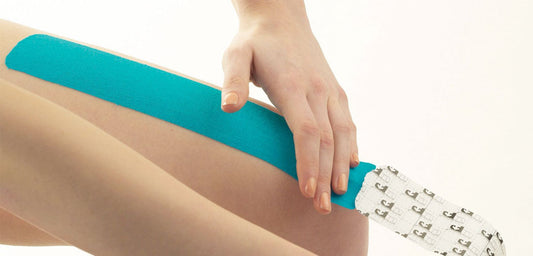
Kinesiology Tape For The Back
Share
Kinesiology taping for the back is often used to provide support, and relieve pain in various musculoskeletal conditions, including back pain. Neal Reynolds of Sportsinjuryclinic.net demonstrates a simple technique for applying Kinesiology tape on the back.
Apply the tape to the skin with varying degrees of tension in order to achieve the desired effects. Here’s how Kinesiology taping helps alleviate back pain:
Reducing pain
Sensory Feedback: The tape provides continuous stimulation to the skin and underlying tissues. As a result, stimulation interferes with pain signals in the brain. This sensory feedback therefore reduces the perception of pain.
Decompression: Kinesiology tape lifts the skin slightly, therefore, creating more space between the skin and the muscles. This reduces pressure on pain receptors and improve blood and lymphatic flow.
Improved Circulation
Lymphatic Drainage: By lifting the skin, the tape helps improve lymphatic drainage, therefore, reducing inflammation and swelling that causes pain.
Blood Flow: Enhanced blood flow can aid in the delivery of oxygen and nutrients to the affected area, promoting healing and reducing muscle fatigue.
Support and Stability
Muscle Support: Kinesiology tape can provide support to muscles and joints without restricting range of motion. This support can help alleviate strain on the back muscles and improve posture.
Postural Correction: Taping can help maintain proper alignment and posture, reducing the strain on the back muscles and spine.
Improved Range of Motion
Functional Movement: Unlike traditional rigid taping methods, Kinesiology tape allows for a full range of motion. This can help maintain normal movement patterns and prevent stiffness.
Muscle Activation: The tape can facilitate or inhibit muscle activation. This helps to balance muscle activity and reduce compensatory movements that may cause pain.
Psychological Benefits
Confidence and Comfort: The sensation of support from the tape can increase a person's confidence in their ability to move without pain. This can potentially reduce the fear of movement and associated pain.
Application Techniques
The effectiveness of Kinesiology taping depends on proper application. The tape should be applied by a trained professional who understands the anatomy and biomechanics of the body. They should also understand the specific needs of the patient.
Common techniques include using the tape to create tension lines that mimic the action of muscles or ligaments, providing support and aiding in the functional movement of the back.
Evidence and Considerations
While many individuals report positive effects from Kinesiology taping, scientific evidence varies. Some studies support its efficacy in reducing pain and improving function, while others suggest the benefits may be due to placebo effects or individual variations.
It’s important to use Kinesiology tape as part of a comprehensive treatment plan, including physical therapy, exercise, and other interventions as needed.
In summary, Kinesiology taping can be a helpful adjunctive therapy for back pain by reducing pain, improving circulation, providing support, enhancing range of motion, and offering psychological benefits. However, its effectiveness can vary, and it should be applied correctly and used alongside other treatment modalities for the best outcomes.




